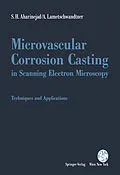Several methods have been used to demonstrate the vasculature of different organs in man and other species. Many attempts to evaluate the precise microangioarchitecture of organ systems remained unproductive, others were controversial. The development of electron microscope in thirties opend new perspectives in researching microvascular systems. Transmission electron microscopy provided a two-dimensional view on microcirculatory system at higher magnifications, however, its standardization was delayed unnecessarily. The use of methyl methacrylate and related compounds for obtaining replicas of vascular beds, and their study in scanning electron microscope opened a new window in micromorphological research. For the first time, a three-dimensional image analysis of the vascular system was possible. The microvascular corrosion casting method has meanwhile attracted the interest of many contemporary scientists. Its application to medical and biological problems justify it to be used as a routine method for microvascular investigations. The first investigators who used this method, focused either on methodological details or they dealt with the normal microanatomy of organs. The advantages of this method in demonstrating pathological microvascular patterns are also evident.
Inhalt
I Techniques of Microvascular Corrosion-Casting.- 1. Corrosion Casting-A Historical Review.- 1.1. Pre-Corrosion Casting Era.- 1.2. Corrosion Casting Era.- 2. Principles and Fundamentals of Microvascular Corrosion Casting for SEM Studies.- 2.1. Physico-Chemical Properties of Casting Media.- 2.1.1. Chemistry.- 2.1.2. Viscosity.- 2.1.3. Replication Quality.- 2.1.4. Corrosion Resistance.- 2.1.5. Shrinkage.- 2.1.6. Spatial Distortions.- 2.1.7. Thermostability.- 2.1.8. Electrical Properties.- 2.2. Pretreatment of Objects for Casting Studies.- 2.2.1. Anticoagulants.- 2.2.2. Vasoactive Drugs.- 2.2.3. Spasmolytic Drugs.- 2.2.4. Anesthesia.- 2.2.5. Preparation of the Injection Site.- 2.3. Fundamentals of Perfusion and Infusion Techniques.- 2.3.1. Perfusion Pressure.- 2.3.2. Perfusates.- 2.3.3. Perfusion Apparatus.- 2.4. Treatment of Injected Specimens (Tissue, Organs, Whole Bodies).- 2.4.1. Polymerization.- 2.4.2. Maceration.- 2.4.3. Decalcification.- 2.4.4. Cleaning (Rinsing) Procedures.- 2.4.5. Drying Vascular Corrosion Casts.- 2.4.6. Mounting the Specimens.- 2.4.7. Rendering Casts Conductive.- 3. Fundamentals of Scanning Electron Microscopy.- 3.1. Scanning Electron Microscope Column.- 3.1.1. Beam Generating System: Electron Gun.- 3.1.2. High Vacuum System.- 3.1.3. Focusing and Scanning System.- 3.2. Specimen Chamber.- 3.2.1. Specimen Stage.- 3.2.2. Detector.- 4. Producing Optimal Microvascular Corrosion Casts-A Practical Guide.- 4.1. Materials and Equipment for Preparing Microvascular Corrosion Casts.- 4.1.1. Rinsing (Flushing) Solutions.- 4.1.2. Fixatives.- 4.1.3. Perfusers and Infusers.- 4.1.4. Tubings, Needles and Cannulas for Injection.- 4.1.5. Micromanipulators.- 4.2. Casting Media.- 4.2.1. Mercox-Cl-2B (2R, 2Y).- 4.2.2. Improved Murakami's Plastic.- 4.2.3. Batson's # 17.- 4.2.4. Araldite CY 223 According to Hanstede and Gerrits.- 4.2.5. Polyester.- 4.2.6. Tardoplast According to Amselgruber et al..- 4.2.7. Latex According to Frasca et al..- 4.2.8. Plastogen G According to Rosenbauer and Kegel.- 4.3. Whole Animal Injections.- 4.3.1. Preparation.- 4.3.2. Injection.- 4.4. Casting the Vascular Bed of Excised Tissues and Organs.- 4.4.1. Pretreatment of Excised Tissues and Organs.- 4.4.2. Preparation of Vessels for Cannulation.- 4.4.3. Specific Needs.- 4.5. From the Injected Object to a Clean, dry Microvascular Corrosion Cast.- 4.5.1. Polymerization (= Setting, Curing, Solidifying, Hardening).- 4.5.2. Maceration (= Digestion, Corrosion).- 4.5.3. Decalcification.- 4.5.4. Intermediate Rinsing.- 4.5.5. Final Cleaning of Specimen.- 4.5.6. Drying Microvascular Corrosion Casts.- 4.6. Mounting Corrosion Casts.- 4.6.1. Specimen Stubs.- 4.6.2. Materials for Mounting Vascular Casts.- 4.7. Rendering Vascular Corrosion Casts Conductive.- 4.7.1. Chemical Methods.- 4.7.2. Physical Methods.- 4.8. Examining the Vascular Corrosion Cast in the Scanning Electron Microscope (SEM).- 4.8.1. Running the SEM.- 4.8.2. Specimen Stages.- 4.8.3. Documentation.- 5. Identification and Interpretation of Cast Vessel Structures.- 5.1. Differentiation of Vessel Types.- 5.1.1. Arterial Vessels.- 5.1.2. Venous Vessels.- 5.1.3. Capillaries.- 5.1.4. Sinusoids.- 5.2. Specific Structures of Cast Vessels.- 5.2.1. Venous Valves.- 5.2.2. Intraarterial Cushions.- 5.2.3. Endothelial Cell Structure.- 5.2.4. Trapped Blood Cells.- 5.3. Surface Structures of Microvascular Casts Reflecting Vessel Wall Components.- 5.3.1. Smooth Muscle Cells of the Vessel Media.- 6. Quantification of Microvascular Corrosion Casts.- 6.1. Parameters to be Measured in Microvascular Corrosion Casts.- 6.1.1. Diameter (Radius), Perimeter, Length.- 6.1.2. Branching Angles and Polar Coordinates.- 6.2. Methods for Quantification of Microvascular Corrosion Casts.- 6.2.1. Planimetry.- 6.2.2. Point-Counting Methods.- 6.2.3. Image Analysis.- II Microangioarchitecture of Selected Organ Systems.- 1. The Cardiovascular and Respiratory System.- 1.1. The Cardiovascular System.- 1.1.1. The Arteries, Veins and Capillarias.- 1.1.2. The Heart.- 1.2. The Respiratory System.- 1.2.1. The Lung.- 1.2.2. The Pleura.- 1.2.3. The Trachea and Larynx.- 2. The Digestive Tract.- 2.1. Oral Tissue.- 2.1.1. The Tongue.- 2.1.2. The Gingival, Buccal, and Palatal Tissue.- 2.1.3. The Teeth.- 2.1.3.1. The Periodontal Ligament.- 2.1.3.2. The Dental Pulp.- 2.1.4. The Salivary Glands.- 2.2. The Esophagus, Stomach, Small and Large Intestine.- 2.2.1. The Esophagus.- 2.2.2. The Stomach.- 2.2.3. The Samll Intestine.- 2.2.4. The Large Intestine.- 2.3. The Liver, Gallbladder, Bile Ducts and Duodenal Papilla.- 2.3.1. The Liver.- 2.3.2. Gallbladder and Bile Ducts.- 2.3.3. Duodenal Papilla.- 3. The Endocrine System.- 3.1. The Pancreas.- 3.2. The Thyroid and Parathyroid Gland.- 3.3. The Adrenal Gland.- 3.4. The Stannius Corpuscle.- 4. The Urinary System.- 4.1. The Kidney.- 4.2. The Ureter and Urinary Bladder.- 5. The Reproductive System.- 5.1. The Testis, Vas Deferens, Spermatic Cord, and Epididymis.- 5.2. The Penis.- 5.3. The Prostate.- 5.4. The Ovary.- 5.5. The Uterus.- 5.6. The Uterine Tube.- 5.7. The Placenta.- 5.8. The Mammary Gland.- 6. The Hematopoetic System.- 6.1. The Spleen.- 6.2. The Thymus.- 6.3. The Bone Marrow.- 7. The Lymphatics.- 8. The Nervous System.- 8.1. The Central Nervous System.- 8.1.1. Main Cerebral Blood Supply.- 8.1.2. Microvascular Architecture of Selected Brain Areas.- 8.1.2.1. Cerebral and Cerebellar Cortex.- 8.1.2.2. Circumventricular Organs.- 8.1.2.3. Hypothalamus.- 8.1.2.4. Hypophysis.- 8.2. Peripheral Nerves.- 9. The Peripheral Sense Organs.- 9.1. The Gustatory Apparatus.- 9.2. The Olfactory Apparatus.- 9.3. The Visual Apparatus.- 9.4. The Auditory Apparatus.- 9.5. The Integument.
